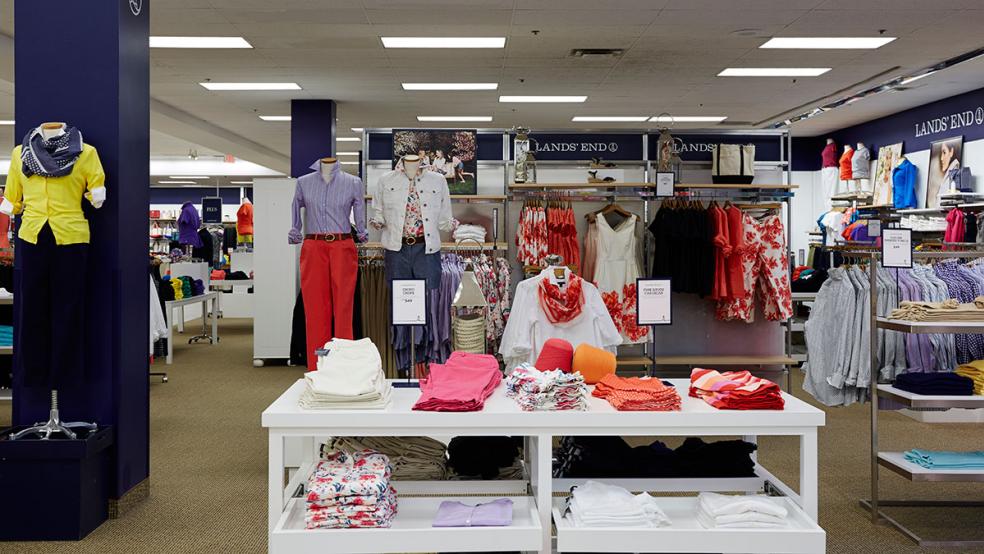You could see trouble coming a mile away, or at least from as far away as your mail box.
Lands' End catalogs started showing up with skinny models adorning the cover, wearing clothes that looked decidedly un-frumpy and un-boxy — in other words, very un-Lands' End. And that chicken-legged model has come home to roost: Facing two consecutive quarters of earnings losses and a drop in share price from $26 to $15 over the past year, the company's short-lived CEO, Federica Marchionni, was forced out of her position this week.
Marchionni came to Lands' End in February 2015 from Dolce&Gabbana USA, where she was president. Before that she was a senior vice-president at Ferrari. Her hiring was an obvious departure for the steady-eddie Midwestern clothing company, which was trying to rev up its brand and appeal to the fashion-conscious consumer who might otherwise be shopping someplace trendy like H&M, or even J.Crew — another clothier that got its start as an essentials-driven catalog shop, but which eventually became a fashion destination in its own right (though the luster has worn off that brand, as well).
Related: The Fashion Item that's a Better Investment than Stocks and Gold
Lands' End began in 1963 in Chicago when Gary Comer, an avid sailor, opened Lands' End Yacht Stores, Inc. The following year the company published its first catalog. Over the years Lands' End evolved from a sailing-set niche into a far more general home, hearth and apparel retailer, becoming big enough and ambitious enough to go public in 1986.
The brand was never known for its fashion, though it did gain enough presence and cachet with a certain crowd to be acquired by Sears for $1.9 billion in 2002; the deal gave Lands' End a massive amount of direct retail space and gave Sears, perhaps, some help in softening its tools-and-appliances image and overhauling its declining brand. But by 2014 the marriage was over. Lands' End once again became its own publicly traded company, but now faced its own brand decline and placed a bet on Marchionni's upscale and luxury goods experience — similar to how J.C. Penney failed bet that Apple’s retail chief could bring some luster to its Middle American brand.
Once again, the focus on high fashion wasn’t a good fit. Lands' End had found a niche in high-waisted jeans and practical outerwear. The company had to try something, so it’s perhaps understandable that Marchionni and the board tried to take the sleepy Wisconsin clothing company someplace new, someplace fashionable, even if it was possibly doomed from the start. But swinging all the way to slim-fit styles and SoHo pop-up stores was bound to turn off much of the brand’s core demographic. It’s not easy convincing middle-America to give up its taste for ill-fitting clothes. And the younger, more fashionable shoppers Marchionni was after can be even more difficult to sway.
Related: Why Ralph Lauren Stepped Down as CEO of His Fashion Empire
On top of all that, Marchionni reportedly was hardly ever at Lands' End's Dodgeville, Wisconsin headquarters, instead preferring to office out of New York — angering employees at the same time the company's turn away from frumpy fashion angered its loyal customer base.
Back to the Boxy Drawing Board?
One unnamed Marchionni defender told The Wall Street Journal that the CEO wasn’t given enough time to fully test her turnaround strategy as the board focused on short-term results. Direct sales fell by almost 7 percent in the second quarter and same-store sales fell in each quarter Marchionni was at the helm. Land’s End now has a market capitalization of more than $480 million, a far cry from where it once was. Analysts predict a return to profitability in the fourth quarter, but it’s not clear whether another year or two under the fashionista would have resulted in a more sustained lift — especially at a time when so many traditional retailers are struggling, including Sears, which is still home to the vast majority of Land’s End locations.
Now the search is on at Land’s End for a new, permanent CEO. In the meantime, the company will be run by Joseph Boitano, the chief merchandising and design officer, and James Gooch, the COO and CFO. The interim co-CEOs were both brought on during Marchionni's tenure. Until a new CEO is brought on, and Lands' End can figure out its next fashion port-of-call, the interim CEOs will likely continue splitting the difference: hoping against hope that plaid flannel shirts paired with stilettos still might be the next big thing.





